| |
THE PRESENT IS THE RESULT OF THE PAST XVIIII
Welkom bij de opening
op zaterdag 1 juni
17 tot 19 uur
in
LOCUS SOLUS
Pourbusstraat 14, Antwerpen
van de tentoonstellingen
Hendri van der Putten
UPDATE

Inleiding: Kornelia von Berswordt, Schwerin.
Presentatie van het boek EEN GAAT - EEN KOMT, 2003 - 2013.
-----------------------------------------------------
In het prentenkabinet van LOCUS SOLUS
FLOOR VAN KEULEN
HELEMAAL HIER
TEKENEN ALS HANDELING

De tentoonstelling is te bezichtigen
van 1 juni - 29 juni 2013
van 14 - 18 uur
www.citythoughts.org/locussolus | |
|---|
 .jpg) | |
Nothing remains... the way it is
One goes – one comes” is a 44-part work by Hendri van der
Putten that first went on public display in 2004 at Rotterdam’s
“ramfoundation”. There, it was hung as a set of four rows
of 11 works, each sized 60x30 cm. The entire work covered a wall
surface of about 2.60 x 3.50 meters. As an offer to viewers by way of
variation, there are four stacks of 11 respective works, in other
words an entire second set with another 44 color panels, stood one
behind the other on the floor.
The vertical format of the individual panel or parts is a structure
already to be encountered in Medieval altar paintings, such as
Bertram von Minden’s Grabow Altar of 1394 (Kunsthalle Hamburg)
which uses 4 x 6 interlinked panels to represent the story of
Creation in Christian legends and teachings. Such vertical formats
are also customary in Asian art, given the flexible perspective they
afford. The eye follows the action in the image through space, and as
in the Middle Ages, even across different times. The story can thus
be presented in terms of a development, without any point in time or
angle defined. This form of vertical format has a powerful, active
effect and is therefore very suitable for combinations of images,
unlike landscape formats where each individual image exudes
tranquility and harmony. Vertical formats are thus more appropriate
for dynamic images – instability, uncertainty, drama and
tension are associated with the very format.
With a few symbols added to them, the power of the 44 parts of “One
goes – one comes” increases immensely as regards their
depth and reach. The interlinkages of the 44 portrait formats
combines to form a single landscape format. This is why the overall
image is so dynamic and so infused with tension, something that
changes from one version to the next, even if individual panels from
the first version have been retained to this day. For the open
potential for change is the fundamental concept underlying “One
goes – one comes”.
Colors that were used in the parts for the first version are repeated in
prints made using stencils – visually they function to bracket the individual parts.Moreover, new and separate panels were prepared, grounded with the same colors.
These additional, monochrome panels, each only boasting one color,
stood on the floor alongside the presentation as swaps that could
supplement the image made with the first 44 pieces on the wall.
The overall image of “One goes – one comes” was
designed from the outset with its mutability in mind. The very title
of the piece intimates that one part is as good as any other part.
All parts can be exchanged and are equal. Exchangeability and
transience play a key role in Hendri van der Putten’s oeuvre:
the interplay of light and shadow, the fleeting views and movements,
forgetting and oversight, these are all important constants in her
work. She has drawn visual interactions between participants in TV
panels and the motion of a dog wagging its tail. Forgetting and
insertion of symbols, the wit or incomprehensibility of ad slogans,
the absurdity of words and language, these are important, recurrent
themes in her oeuvre. For we often only perceive visual shapes and
patterns subconsciously, they only serve as orientation in everyday
life and are thus an essential part of perception. Their open and
exchangeable character is part of our everyday experience of change.
Each and every viewer participates in the concept of this piece. The image
as a whole is never finished or complete, its visual or temporal
reach never clear or subject to complete control. The concept remains
open and incomplete, Hendri von der Putten devised the concept
specifically with a view to its dynamism, mutability and open
development.
You can acquire single or several parts of the work and simply take it or
them from the wall. The colored parts at hand are then inserted into
the gaps. Hendri van der Putten revises the work in its entirety in
each version ready for the next show. Each version is exhibited on
its own, but all the versions are never on show at one and the same
time. They are only to be seen over time, in the different versions
one after the other. Photographs document the different versions and
the changes to the work and are accessible to all participants. The
low price of only EUR 500 per individual panel section ensures many
people can take part in the changes and also facilitates its
presentation on the Internet at http://www.hendrivanderputten.nl/project.html
After a decade, “One goes – one comes” now exists in six
presentations or versions. The overall image has varied depending on
the venue: in Rotterdam, Goes, Delft, IJmuiden, Loitz, and Antwerp.
Photographs document how “One goes – one comes”
changed on each occasion. The work remains conceptually open in terms
of both title and realization, as can be readily gleaned and grasped
from the process of change.
In
the very first version all the parts had a white ground. Hendri van
der Putten painted them by hand, and used stencils to apply the
stamped shapes. The act of painting and the traces of stencils cut
across various parts and at the same time thus fuse them to form a
single image. After the first show, 12 new panels with different
colors were inserted, replacing 12 extant ones. The new items had a
grounding in red, blue, green, ocher, gray, black, brown and bright
yellow, functioning in the overall image as hard, constructive
interruptions compared to the fluid painterly coherence of the panels
from the first version. Hendri van der Putten continued to paint the
later versions of “One goes – one comes” freely by
hand and created a new visual balance by using new stencils (in
bright circles and black angles) running from edge to edge, from one
row to the next. She continued to work on the piece from one show to
the next and in the course of time it changed radically.
The concept behind “One goes – one comes” is also clear
from the system of spreading the title across the individual panels:
on the cover of the catalog keywords from a list are placed one below
the other. For the first version of “One goes – one
comes” the individual words relevant to the choice of title are
printed in color and each is denoted by squiggle. These together form
the title for the first and for subsequent versions. In the first row
these were from top to bottom, for example, for the key word “en”
– and :
en ....dan....
and .......... then
en ....of........
and......... or / definitely
en.... zo voort.........
and......... so forth
en.... die zei.............
and......... s/he said
Each keyword can linguistically be supplemented:
and, you can, there is, it can, as, alone, you will, you want, it is, you
wanted, it does, that is, it can, how, you will,
The fun sets created by combining words from the table can be read as
titles, the meaning of which is clear, but open. The puns are not
clear definitions or titles such as are customary in art history (à
la “Man with dog”, “Still Life with Apple”)
and instead, with the squiggled supplement offer a meaning that
involves possibility as it could be quite different if combined with
a different word from the list.
The bit of the title allocated to each section can be readily seen with a
click on the individual section if you are online or constructively
with the help of the list from the catalog. It is important for
Hendri van der Putten that there is playful linguistic scope as
regards the titles of the sections, i.e., the “names” of
the images – this corresponds to the piece’s overall
concept. The exchangeability and openness of the language games
mirrors the concept of the role of the parts of the picture for the
whole painting. Thus, the open principle of painting is transposed
into the realm of language and used there, pointing up the titles of
the parts, their equal status and exchangeability. For every part of
the title can likewise be replaced by another word and for the next
version with new parts, other names can be chosen from the same list.
The linguistic fun presents the potentiality of all variations innate
in this piece. The viewer can easily find his or her way visually and
linguistically into the system and in the process of the concept, and
chose the image visually or by title. This open variability and
playful freedom forges links to van der Putten’s former works.
Hendri van der Putten used words, concepts, quotes or names in earlier
pieces. For example, when traveling she collected words or phrases in
her notebook. Foreign words or strange phrases that lodge in your
mind, irrespective of whether their meaning is readily
comprehensible. Back in her studio, she stamped a selection of the
words of phrases onto canvas using thick coat of paint, whereby the
stamps were then impressed onto another canvas, which had a thin
grounding of color. The idea was not for the printed words to
necessarily be legible or discernible, and the difference in the
impression of the stamped words on the two adjacent canvases
corresponded roughly to the fleetingness of our perception. Just as
traces of memories get dispelled from our minds over time, so too a
glance back can like repetition reconstruct fleeting impressions.
What we see in van der Putten’s dual images is how mobile and
transient visual perception are for the human mind. We perceive
unknown words, symbols or terms because they guide us in strange
environments. It is irrelevant whether we know their content or
precisely understand their meaning. Once visually perceivable and
sensorily emphatic, symbols and images strengthen our memory of a
setting, become bonded emotionally with that place.
Hendri van der Putten recorded the transience and indeterminacy of
impressions and images in drawings of visual interaction between two
participants respectively in TV panels. In the drawings, the focus is
not on the people, their statements or the meaning of such exchanges
of looks, but on the dynamism of the movement, its fleeting
character. Because only in exceptional cases do the participants
themselves recall such visual interaction. The concept behind the
drawings makes the interaction discernible as a structure, the
entirely transient becomes a shape, lines in space, and thus a
representation of time in space that we can discern in three
dimensions. The abstraction innate in the networks of lines reveals a
system of mnemonic traces of actual visual interaction with the
associated emotional states – there is no linguistic form or
visual representation of this otherwise.
Supplementation
and imagination is a principle underpinning the “silhouettes”,
drawings of shadows. In the “vorm en schaduw” series the
outlines of shapes that are set against the light, i.e., shadows,
become shapes in their own right. She has molded the shadow of an
orange or a door corner in clay or dyed artificial resin. The
intangible shadows become tangible in several dimensions. With such
extensions, things lose their evidently fixed shape and fleeting,
wandering shadows turn into something new. Their immaterial nature is
given potentiality in real space, and the changes and extensions to
such non-things expands our experience of reality and undermines the
certainties it purports to have.
In her art, Hendri van der Putten addresses not only the visual and
formal properties of things and shapes, their transience,
exchangeability and the function of coincidence. She eschews central
perspective, a central point or axis in her work whence all else in
the composition could be measured or defined or simply organized. She
wants instead to highlight the search and potential for different
perspectives in the representation.
The pieces focus on direct visual certainty, and yet one that is itself
fleeting, albeit not on transience itself. Even if movements are
fleeting, the moment in which one sees movement is clear and defined,
thus and not otherwise.
The viewer is meant to be able to turn and change an image as if seeing
it in a kaleidoscope. “One goes – one comes”
changes along with the viewer, it refuses to remain similar at either
level. The pictorial space is flat, bereft of all optical illusion or
perspective, the image is an image, nothing more, irrespective of the
variations. Yet qua section each section can visually influence the
one next to it on either side, the one above or below it. Thanks to
the openness, the impression the whole picture gives also changes; in
each new version of “One goes – one comes” this is
visually manifest and documented. For all the parts from the first
overall presentation of the entire image have changed, other than the
panels that were extracted from the presentations and handed over to
buyers. The overall image today is looser and lighter in tone than in
the initial version of 2003-4. The panels had different colors and
were densely coated, on an even white grounding. The new panels have
a color grounding, and bear far fewer painterly lines or traces of
stencils. The sections from the first version were coated with an
increasing number of layers of colors and shapes, while the add-in
panels bear less painting. The shapes of the stencils function as a
visual bracket for the new and the old panels, keeping everything in
balance. As regards the sense of depth, there is now more air and
space overall, even if this has first evolved gradually with sections
being replaced in the course of work and exhibition venue. For only
then are additional parts replaced such as to make such a change
possible. The variability underlying “One goes – one
comes” remains open and accessible for both artist and viewer
alike.
(Johanna Schenkel)
| |
|---|

hendri van der Putten, Groenland, 1976 | |
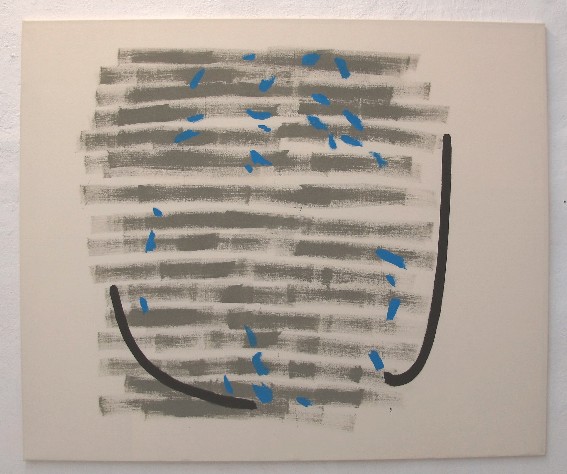
Hendri van der Putten, Z.T. , 1986 | |
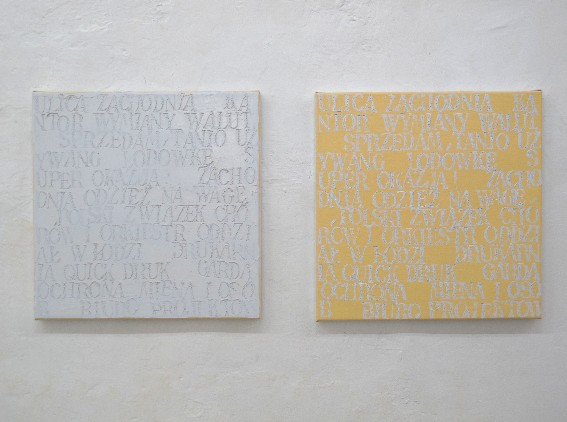
H.van der Putten,ULICA ZACHODNIA,,1992.jpg | |
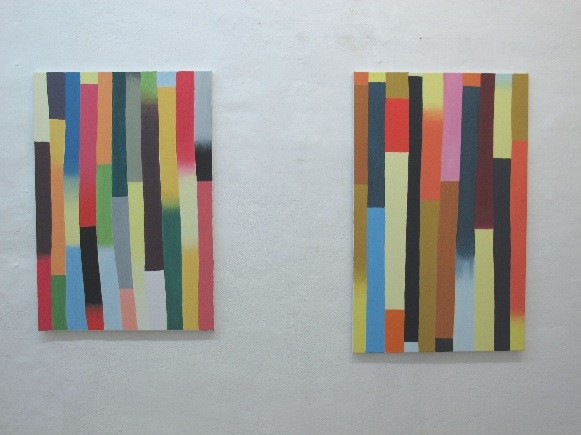
Hendri van der Putten, Kleuren, 1995 | |

H.van der Putten, Z.T. 1986,Locus Solus 2013 .jpg | |
|
.jpg) | |
Floor van Keulen
HELEMAAL HIER
TEKENEN ALS HANDELING
1 - 29 juni 2013
De Nederlandse kunstenaar Floor van Keulen is een gedreven tekenaar. Uit de beweging van zijn hand ontstaat een hallucinante wereld, bevolkt door fabelwezens, die een eigen leven leiden . Tijd en ruimte krijgen andere dimensies.
Niet alleen op papier, de gebruikelijke drager van de tekening, werkt Floor van Keulen. Hij laat het liefst sporen na op wanden, vloer en plafond, om hem heen. Als een Pollock laat hij zich niet begrenzen in zijn bewegingen. Vandaar dat hij in 1979 met zijn tekenacktiviteit welkom was in het toen toonaangevende Centrum van de Performance Kunst, DE APPEL in Amsterdam. Zijn tekenen werd daar in aanwezigheid van het publiek gepresenteerd als een ter plekke uitgevoerde handeling. Sindsdien zijn er talloze van dergelijke tekenperformances gevolgd, vaak in Musea: Fodor in Amsterdam, het Centraal Museum in Utecht en het Van Abbe Museum, of andere kunstplekken zoals Arti in Amsterdam. Kenmerkend is dat deze in situ uitgevoerde tekeningen even vluchtig zijn als de graffiti in de straten en na een kortstondig bestaan weer verdwijnen. Anders dan de stereotype graffiti zijn het persoonlijke uitingen met een eigen karakter, die alleen als fotodocumentatie bewaard blijven. Dat geldt ook voor de experimenten met computerprojecties op huizen in de stad, waar Van Keulen zich de laatste tijd mee bezig houdt
Recentelijk is een grote publikatie over al die niet meer bestaande werken verschenen: FLOOR VAN KEULEN, LOST PAINTINGS, 1965 - 2011, met teksten van Rudi Fuchs, Tom Rooduyn, en Annemarie Smolders.
Ook in LOCUS SOLUS zal Floor van Keulen ter plekken een tekening in de ruimte van het souterrain maken, in samenhang met een overzicht van kleinere werken op papier , product van een virtuoze hand die nooit rust kent.
Zie ook : Franck Gribling, FLOOR VAN KEULEN. TEKENEN ALS PERFORMANCE, in DE NIEUWE,Jaargang17, nr 28, p.22
| |
|---|
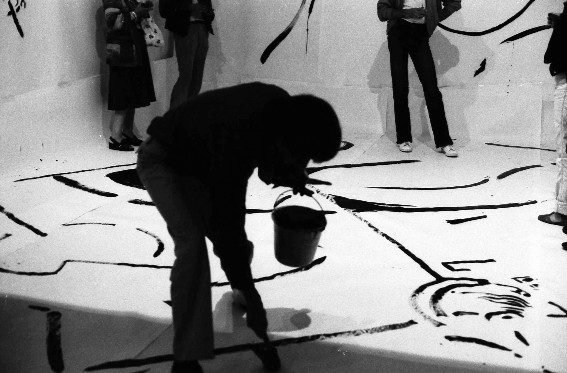
Floor van Keulen. Teken performance, De Appel,Amsterdam,1979 | |
|
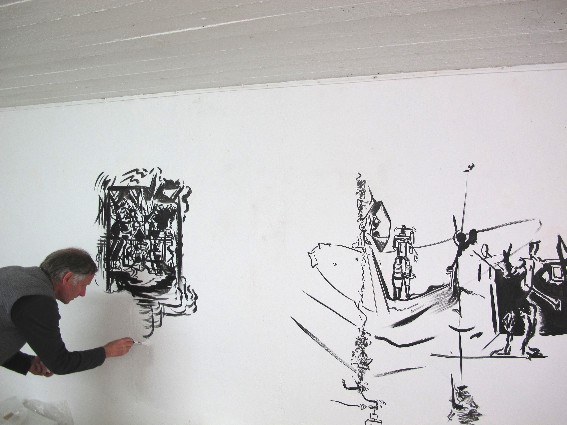
Floor van Keulen aan het werk, Wandschildering, Locus solus, 2013 | |
|
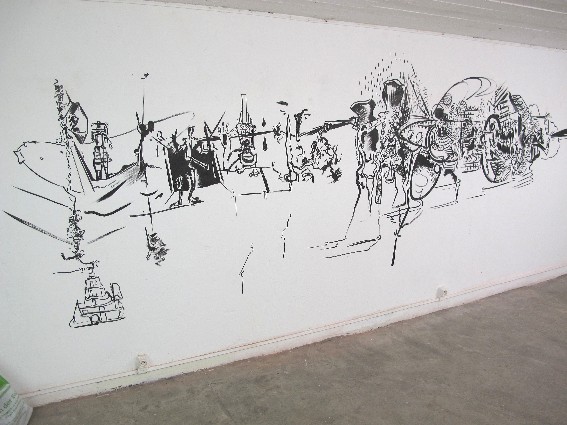
Floor van Keulen, Wandschildering, Locus solus, 2013 | |
|
, 2013 .jpg)
Floor van Keulen, Wandschildering, Locus solus ( detail), 2013 | |
|